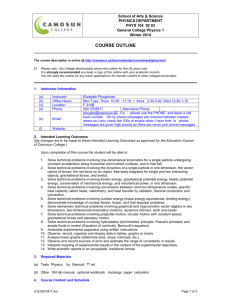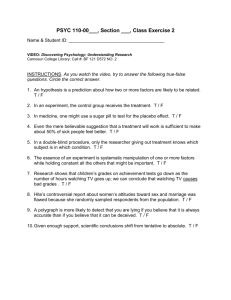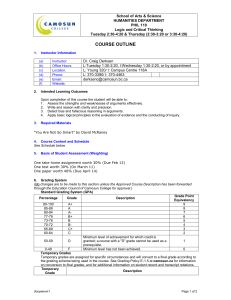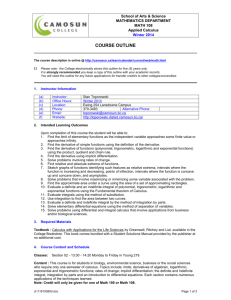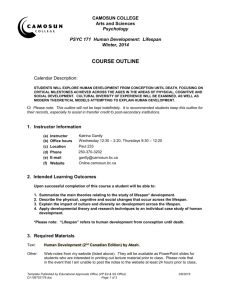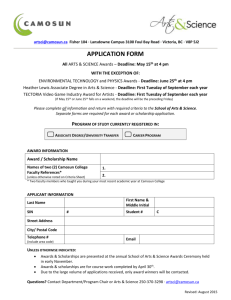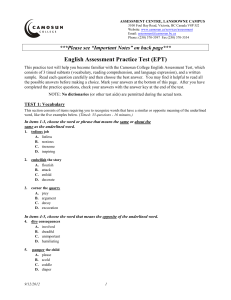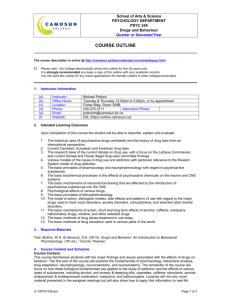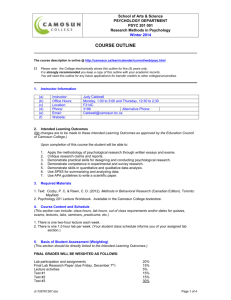Inspiring Learning
advertisement
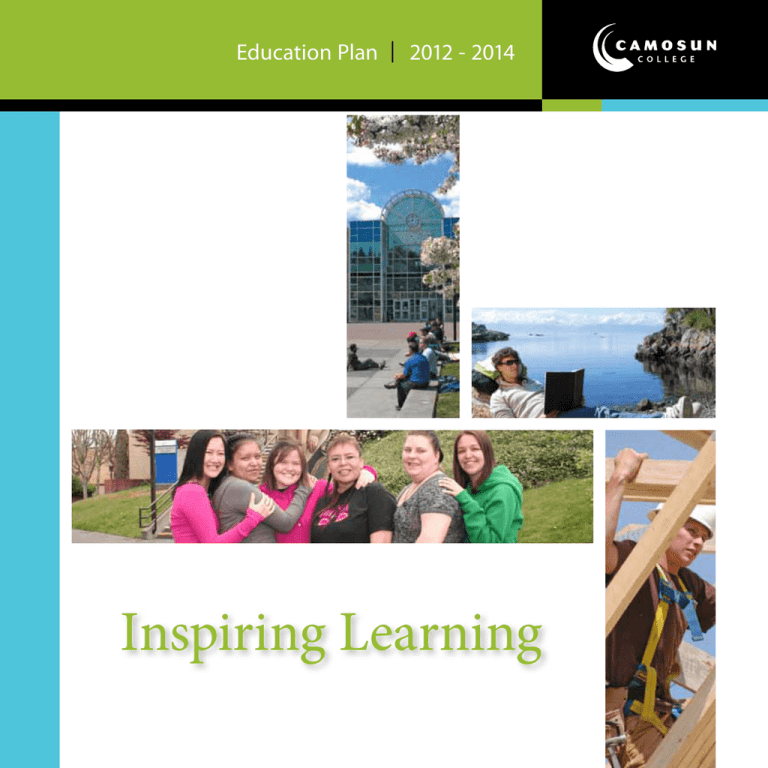
Education Plan | 2012 - 2014 Inspiring Learning Territorial acknowledgement Camosun College is situated on the traditional territories of the Lkwungen, Esquimalt and WSÁNEĆ peoples. We acknowledge their welcome and value their friendship. 2 Education Plan Table of Contents Territorial Acknowledgement2 President’s Welcome4 Vice-President’s Welcome and Introduction5 Vision, Mission, Values 6 Our Educational Principles7 Educational Opportunities for All10 Enhance Program Offerings11 Enrich Program Content11 Provide Flexible Program Delivery12 Enhance Program Pathways 13 Teaching Excellence14 Services that Inspire16 Support Faculty Development16 Expand Distributed and Distance Education17 Enrich Learning Resources18 Improve Curriculum Development, Approval and Renewal19 Accessibility and Student Success20 Appendices22 Appendix A – Leading Practices in Curriculum22 Appendix B – Programming Priorities for 201223 Appendix C – Glossary 24 Camosun College 3 President’s Welcome Camosun’s strategic plan, Inspiring Lives, was launched in the autumn of 2011, setting an exciting and ambitious course for us for the period ahead. Core to the plan, which includes an inspiring new vision, mission and values, is our commitment to life-changing learning. Inspiring Learning is a redraft of our previous Education Plan 2010-11, updated to align more closely with the direction and content of Inspiring Lives and to reflect work completed since then. Whether you work directly with our learners or have a supporting role, I think you will be inspired as you read the pages that follow. There are so many opportunities and ways to become more involved in or support the dynamic teaching and learning process for which we have become known. I look forward to working with and supporting you as we realize our vision of becoming Canada’s college of life-changing learning. Together we can. Kathryn Laurin President 4 Education Plan Vice-President’s Welcome and Introduction Camosun College has a long and proud history of serving students and contributing to community social and economic well-being. We have become known and respected for the work we do and have done over the past forty years as one of the country’s exemplary community colleges – Canada’s college of life-changing learning. We cannot, however, nor would we want to, rest on our laurels. To seek and sustain this title means that we need to be continuously engaging with each other, with our learners, with industry and with the community. This allows us to stay abreast of change and to find new and innovative ways to stimulate and enrich the teaching and learning process, and to provide ever more responsive service and support. We have tremendous opportunities to re-imagine every student interaction as an opportunity for life-changing learning, to innovate, to build a culture of excellence, and to engage with each other across programs, disciplines and professions. I hope you are inspired by the path ahead and that you will find within the following pages many opportunities to lead, engage and serve as we maintain our place as Canada’s college of lifechanging learning. John Boraas Vice-President, Education Camosun College 5 Vision Inspiring lives. Canada’s college of life-changing learning. Mission We build a better tomorrow by providing outstanding and relevant learning experiences, valued credentials, and life-long student success. Values Our learning values We value life-long learning. We value self-directed and collaborative learning experiences. We value the practitioner of knowledge. We value flexible and accessible learning. Our service values We value excellence in our service to students and communities. We value the continuous improvement of our services and programs. We value collaboration across the college. Our leadership values We value the development of leaders. We value intelligent risk taking. We value creativity, innovation and imagination. We value the courage of the change agent. 6 Education Plan Our Educational Principles Our educational principles embody our vision, mission and values. They reflect our commitment to being Canada’s college of life-changing learning, guiding the development and delivery of quality education that meets the current and future needs of individuals and communities we serve. At Camosun, we: embrace student learning as our core purpose. promote student success through flexible, responsive and caring philosophies and practices. provide a welcoming and engaging learning environment that is respectful, inclusive and fosters student learning and achievement. believe learning is an active process that occurs both in and outside of the classroom. engage with each other across disciplines and professions, and across programs and services, to enrich and broaden students’ learning experiences beyond classroom walls. strive for excellence in learning and teaching by engaging students, using outcomes-based educational practices and fostering life-changing learning. aspire to be leaders in Indigenization, internationalization and the promotion of global citizenship. honour our identity as a community college, acknowledging our roots in applied learning, labour force development and the social and economic development of communities we serve. “ demonstrate responsibility and accountability in all we do. – A certain balance had been restored...He had made good choices. He had confronted conflict. Struggle had served a good purpose.” John Borrows (Anishinaabe), Drawing Out Law: A Spirit’s Guide, (2010) Camosun College 7 Planning Context Camosun’s strategic plan, Inspiring Lives, embodies the dreams and aspirations we have defined for ourselves as Canada’s college of life-changing learning. The result of a significant and widespread consultation process, it provides the direction and foundation for this updated Education Plan. As you read through this Plan, you’ll see the educational principles, goals and strategies all contribute to the actualization of Inspiring Lives. The Education Plan is the first of a number of plans that will focus our energies in pursuit of our vision. Inspiring Lives Inspiring Learning Marketing Plan CI Plan Educational Technology Plan Financial Plan IT Plan 8 Education Plan People Plan Campus Plan Camosun international (ci) and International field schools Camosun students have opportunities to participate in field schools in India, Mexico, Nepal, Namibia, the Philippines and Tonga or exchange programs in one of 18 institutions in 14 countries. Student Success According to the province-wide Student Outcomes Survey 2011, overall satisfaction with the education they received was very high for Camosun students, with 94% either very satisfied (42%) or satisfied (52%). Almost nine out of 10 students (87%) reported that their most important objective in attending the college was either completely or mostly met. Over 650 international students from more than 50 different countries are enrolled each year. In addition to providing support services to students, Camosun International also provides leadership together with the schools on educational projects around the world while also offering on-site customized training programs to international clients and partners. Of the 57% of students who were continuing their studies, almost all (95%) reported they were either very well or somewhat well prepared for further studies. More than four out of five said their Camosun courses were up-to-date (82%) and relevant (80%) and four out of five (80%) rated the quality of instruction at the college as very good or good. See camosun.ca/about/educational-research/ outcome/outcomes-reports.html for complete report. Camosun College 9 Pillar 1: Educational Opportunities for All For the past four decades, our programs have inspired and challenged the students we serve. We, in turn, have been inspired by our students, communities and each other. Inspiring Lives describes who we are, our collective vision for the future and the values we share, including the continuous improvement of our programs and excellence in our service to students and communities. Our college is the most comprehensive community college in the province. We are known for programming tailored to the needs of Aboriginal learners, working adults, high school graduates, new Canadians and international students, as well as those requiring upgrading or re-training. We regularly rethink and build upon the possibilities contained in our various certificate, diploma and degree programs and program clusters. We create clear transitional pathways for learners entering, moving within and embarking from the college to enter a career or pursue further studies. The learning experiences we provide are rich and varied, with a focus on engagement with and application of knowledge. Our programs are responsive to individual and community needs and emerging trends, such as the demand for collaborative approaches, interprofessional and interdisciplinary programs and for social and environmental responsibility. As we move forward, we may want to ask ourselves: What are the challenges and opportunities contained in our comprehensiveness? What is 21st century learning? How do we re-imagine every student interaction as an opportunity for life-changing learning? How do we ensure the needs of students and community are core to decision making? What might be the balance between fully online distance programming and enhanced distributed learning? How do we organize to support student success? 10 Education Plan The value and passion of Camosun are at the core of all that we do – our future growth and sustainability depend on an effective decision-making framework that is informed by a balanced and considered business case driven by the Education Plan. iNDIGENIZATION The goal of the Indigenization Project is to ensure that all Aboriginal students see their world and realities reflected in the way that Camosun operates and that all nonAboriginal students come away from Camosun better prepared to live alongside, negotiate with and build better relationships with Aboriginal people. To date, 65 Camosun courses have been indigenized and over 120 employees have completed the TELŦIN TŦE WILNEW (Understanding Indigenous People) program, which helps individuals integrate greater cultural awareness into their professional practice, both in the classroom and in their daily interactions with students. We will continue to support indigenization at Camosun College. Enhance Program Offerings Enrich Program Content Our goal is to regularly review, revise and enhance our program offerings to anticipate and respond to the current and projected social and economic needs of our region and those identified in Skills for Growth and other ministry planning priorities. Our goal is to provide program content that is relevant, leading edge and reflective of a distinctive Camosun educational experience. Strategies: We will: We will: foster an environment that inspires life-changing learning, building knowledge, understanding and new insights that strengthen, shift, confirm or challenge our existing notions, ideas or beliefs; proactively engage with the community to determine its educational, economic and social needs and develop processes and structures that enable us to effectively meet these needs; annually review the value and sustainability of all programs; add new programs to address current needs and lead our communities forward including: i. innovative interdisciplinary and interprofessional programs, in response to growing demand for broadly integrated knowledge and practice; ii. new and existing collaborative arrangements with external partners; iii. programming for international students and for immigrants who are trained professionals; seek additional new funding and tuition models to expand existing high-demand programs and to add innovative new programs; and actively engage in a process to identify and develop a limited number of strategic Centres of Excellence. “ Strategies: endorse an outcomes-based learning approach to curriculum development and design, incorporating the concepts of significant and relational learning and elements of appreciative inquiry within our curriculum model; build concepts of ecological sustainability and social responsibility into programs and courses to provide students with knowledge and understanding needed to make critical decisions about their future; create innovative, interprofessional and interdisciplinary educational experiences that enrich students, faculty and communities; continue to incorporate and support a strong applied focus within our programs and expand opportunities for work-integrated learning; continue to support the Indigenization of our curriculum; integrate an international/intercultural dimension into curriculum; identify and pursue internationalization initiatives. – We are all born with a gift whether it be good memory, a talent of some kind, and we teach our children to work on that talent so it will be carried on to their children and their children.” Helen Robinson (Uchucklesaht), The Sayings of Our First People (1995). Camosun College 11 Provide Flexible Program Delivery mEMORANDA OF uNDERSTANDING (mou) Our goal is to use a variety of delivery methods to meet the diverse needs of the learner and to enhance traditional classroom learning. Camosun has sought to formalize pathway opportunities that will enable learners to move more seamlessly to further learning opportunities; a priority for the College. Signed MOUs exist with: Strategies: We will: offer more community-based, off-site programming (e.g. in Aboriginal communities and workplace settings); provide a variety of streamlined programs and learning options including work-integrated learning, delivery methods and experiences for learners that lead to successful career opportunities; offer courses and services at times of day and year and at locations that optimize students’ experiences; continue the initiative to move our programming from quarter-based to semester-based; use technology to deliver programs in a flexible combination of methods that address the needs of our learners. The University of Victoria, Royal Roads University, Vancouver Island University, North Island College and Douglas College. Priority pathways for further MOU development include: Mount Royal University BCIT Southern Vancouver Island School Districts Royal Roads University University of Victoria University of Western State Oregon State University Thompson Rivers University Kwantlen Polytechnic University Select private language schools Continuing Education Camosun serves an additional 7,000 learners annually through its continuing education offerings, with more than 200 part-time, daytime and evening courses, including eleven certificate programs in areas as diverse as arts and culture, language, business and leadership, computer training, healthcare and wellness, food and beverage, gardening and horticulture and the trades. New courses and programs are added regularly to meet the changing interests and demands of learners and community. 12 Education Plan Enhance Program Pathways Our goal is to facilitate student transition and create clear pathways from one level of programming to another into and within the college and to receiving and partner institutions. Strategies: We will: develop programming and support for transition into Camosun: i. develop a first-year experience to help new students, including first-generation learners, transition successfully into postsecondary education; ii. provide transitional opportunities for all high school students through dual credit courses and programs; iii. develop and implement a sustainable model for Prior Learning Assessment (PLA) practice and support; iv. provide pathways and programs that attract and support immigrants, first generation and non-traditional learners; facilitate transition from one level of programming to another: i. enhance program laddering, course and block transfer and degree completion opportunities (both internally and with external partners); ii. enhance guidance and support for students in transition; iii. broaden career access program offerings. Leading by example The South Island Partnership (SIP) between Camosun College, southern Vancouver Island’s five school districts and local industry leaders enables students to jump-start their post-secondary education and careers through dual credit programming. It has become the model for such programming province and nationwide. Secondary school teachers, college instructors and employers work as a team to develop and share curriculum and to ease student transitions. Programs exist in business, health care, early learning and care, technology and eleven trades areas. Programming includes advanced placement courses in biology, chemistry, math, physics, business and health – several of these are offered in the West Shore. Students from 23 schools are registered in dual credit opportunities in 2011/12 and over 600 secondary students will be completing their courses or programs. More than 3,000 students have participated in the program over the past decade. Appendix B provides a list of programming priorities. Camosun College Camosun 13 Pillar 2: Teaching Excellence We celebrate excellence in teaching, valuing the practitioner of knowledge and supporting one another in our efforts at continuous improvement. Student learning is at the centre of everything we do, both inside and outside the classroom. The establishment of a Centre of Excellence in Teaching and Learning is a priority for the college and an important means of enhancing our efforts to be leading practitioners in these areas. As a teaching institution, we value and learn from different perspectives. We encourage each other to challenge the status quo. We believe in the power of open, respectful and engaging relationships – among colleagues, with students, and with the “ community we serve. We pride ourselves on cohesive, wellconstructed curriculum that meets the needs and aspirations of our learners. We achieve excellence by focusing on student success; teaching with passion, curiosity and creativity; valuing active learning, student engagement and participation; welcoming diversity; making interdisciplinary connections; and incorporating experiential and applied learning and communities of practice. We seek out, encourage and support instructors who are current in their fields, committed to developing teaching excellence, and collegial and collaborative in their practice. – The words of the elder remind us that each word is spoken is an exercise of power and a use of medicine. Therefore, with our words we can create good medicine. With our words we design our path of life, with the etching of power that lies within the wisdom of the word.” 14 Education Plan Dr. Lee Brown (Cherokee Nation and the Wolf Clan), personal communication by permission. Supporting and Enhancing Teaching Excellence Our goals are to: i. create innovative, interprofessional and interdisciplinary education that enriches students, faculty and communities; ii. support the excellence of our teachers as leaders of education; and iii. develop a national reputation for excellence in applied research. Strategies: We will: employ teaching and student success strategies that create positive learning environments, foster student engagement and inspire; engage in informal and formal evaluations to enhance teaching excellence; engage in general and/or discipline-specific opportunities, including scholarship, applied research and the sharing and showcasing of leading practice, in support of teaching excellence; encourage faculty and students to engage with a range of industry and community-based research initiatives in partnership with the college’s Centre for Applied Research and Innovation (CARI), the schools and other institutions and agencies; develop and engage in ongoing departmental and cross-institutional mentoring and coaching relationships to support new faculty; provide guidance for students seeking education and career goals and pathways, including referring them to resources and supports that will foster their success and well-being; engage in and collaborate on interdisciplinary and interprofessional learning, teaching and research opportunities; learn and integrate indigenous ways of knowing, learning and teaching into teaching and learning practice; create learning environments that are culturally safe, inclusive and respectful of the diversity of learners; Applied Research and innovation Recently awarded Social Sciences and Humanities Research Council of Canada (SSHRC) eligibility status, Camosun is also one of a few colleges in BC eligible for Natural Sciences and Engineering Research Council (NSERC) funding to support our research and innovation initiatives. We first benefited from such a grant in 2009 when we received a $2.5M over five year grant to support our Sport Innovation Centre in PISE. Becoming eligible for SSHRC is prestigious recognition of the role we play in transforming community, both through economic diversity and social innovation. These funds will not only enhance the student experience but also support new levels of innovation within the wider community. See camosun.ca/about/research/ for more information about current projects and opportunities. use relevant technologies and new and expanded distributed and distance education practices to enhance learning and teaching and increase learner access. Camosun College Camosun 15 Pillar 3: Services That Inspire Student learning and facilitation of student success are at the core of all we do. We value excellence in our service to students, re-imagining every interaction as an opportunity for life-changing learning. We each have a critical role to play, supporting one another in our quest to realize our vision of inspiring lives as Canada’s college of life-changing learning. There are so many ways in which each of us affect the learners’ experience of Camosun or support each other in doing so. For the period of this plan, we will be focusing attention on four broad goals: i. support faculty development; ii. expand distributed and distance education; iii. enrich learning resources; iv. improve curriculum development, approval and renewal. Support Faculty Development learning, and curriculum. Key ways in which teaching excellence is supported include faculty scheduled development and funded professional development, in addition to the wide variety of services and resources available through the Learning and Teaching Centre (LTC). Strategies: We will: establish a Centre of Excellence in Teaching and Learning by expanding the capacity and scope of the existing Learning and Teaching Centre; acquire, develop and use web, print and media resources to support excellence and best practice in teaching, learning and curriculum development; develop new programs (e.g. New Faculty Academy) and continue support to existing ones such as Instructional Skills Workshops, the Instructor Diploma Program and Great Teacher Seminars for both new and more experienced faculty; Faculty development at Camosun encompasses the broad range of practices and supports that foster excellence in teaching, Centres of Excellence A Centre of Excellence at a post-secondary institution is a nexus of expertise, innovation and development in a particular subject or service area established to: 16 • support research, scholarship and knowledge creation in the subject area, • support practical application, innovation and development, • enhance student learning experiences, • recruit outstanding faculty and staff, Education Plan • increase community awareness, outreach and knowledge transfer, • facilitate internal and external partnerships, and cross-disciplinary and cross-functional exchange, and • attract external funding. support the development of educational leadership college-wide through such means as the annual Chairs’ Exchange, the Chairs’ Institute and other events and/or activities; Strategies: promote excellence and leading practice in teaching and learning through events (e.g. Walls Optional Conference) and activities, with special emphasis on leveraging and expanding resources through college and external partnerships; provide an educational learning management system (Desire2Learn) and move toward its ubiquitous use, at minimum, as a supplemental enhancement to teaching and learning in all course sections; recognize and learn from the wisdom of our outstanding teachers and their accomplishments and facilitate communities of practice; offer faculty development, activities and resources to engage faculty in the Indigenization initiative and the Aboriginal Services Plan; encourage the integration of internationalization principles into curriculum, teaching practice and the learning environment; provide opportunities for international experiences for faculty such as field schools and exchanges in partnership with Camosun International; We will: increase the number of complete academic programs and core courses delivered fully online to provide further access and flexibility for learners; provide and expand web-based learning and support to faculty in the best use of a broad range of educational technology tools and applications and a greater array of direct support to students in the DE environment over expanded service hours; implement a multi-tiered faculty support model, including enhanced online self-directed materials, a greater focus on design-oriented development, and a supported faculty peer support model in the schools and departments; promote and support effective use of technologies to support teaching practice. encourage and build upon scheduled development capacity that maximizes faculty knowledge and competence with web-related tools and techniques; Expand Distributed and Distance Education consultatively develop an educational technology plan that integrates the needs of learners and teachers. Our learners are as diverse as we are, with time constraints and other work/life challenges. They, like us, value flexible learning options and opportunities. At Camosun College, we use the term distributed education (DE) to refer to teaching and learning using web technology. Effective use of the technology can provide greater access and flexibility for the learner, enrich the learning experience and enhance student success as well as provide opportunities for innovative teaching and educational leadership within the community. Although DE is becoming ever more ubiquitous in our classrooms and teaching/learning processes, we are challenged to grow programs that are fully online and to provide opportunities and support for students who increasingly demand off-campus participation. Camosun College 17 Enrich Learning Resources The Camosun College Library and Learning Commons are places for collaborative learning and individual study; where students can get research assistance, access an array of information resources, get computer help, writing and learning assistance and where faculty can access resources to enhance their teaching and curriculum development. The distinct service units located in the learning commons develop synergy as a result of their proximity and together commit to exceptional customer service to support student success. In addition to the physical spaces, the libraries have a strong virtual presence, with online access to resources and real-time help services. Library faculty engage with teaching faculty to identify and acquire learning resources, to ensure compliance with copyright and accessibility standards and to incorporate information literacy competencies into curriculum. Camosun has a broad range of highly supportive services for students. Learning Centres in English, math, and the foundations are available for students at the preparatory levels while Centres in math and writing skills exist for post-secondary levels, primarily at the Lansdowne Campus. Given the growth in immigration and International student numbers, expansion of the language help centres at both campuses is a priority. Where feasible, the delivery of learning supports using distributed technology is a priority. Counseling and the Disability Resource Centre will increasingly use alternative delivery methods to support this service – for example, group counseling initiatives and online booking capabilities. Strategies: We will: expand and refresh print and electronic collections to meet the evolving information needs of students and faculty; promote the use of the library’s online and print collections with faculty and students. 18 Education Plan provide guidance to the college community on copyright and accessibility compliance; promote the use of open education resources; enhance online interfaces, primarily the library’s website and within Desire2Learn, to provide seamless access to online information resources; collaborate with faculty to improve students’ level of information literacy; support faculty, staff and administration in research activities; establish learning commons services at Interurban and expand services at the Lansdowne Learning Commons. Work-integrated learning (WIL) Co-operative education is one of the many types of work-integrated learning (WIL) options available to Camosun learners and another area in which our students excel. Associate Degree co-op student Jaimy Simmonds, received the provincial Co-op Student of the Year Award, and Hospitality Management graduate Erica Parsons won honourable mention both provincially and nationally, the fifth consecutive year that Camosun Co-op students have been recognized for this award. Other types of work-integrated learning include internships, service learning, practicums, apprenticeships, field schools and clinical placements. Improve Curriculum Development, Approval and Renewal Completed Program/Discipline/course Reviews 2010 - 2012 1. Indigenous Human Services Access 2. Hospitality Management 3. Integrated Business Case 4. Mental Health and Addictions 5. Community, Family and Child Studies 6. Associate Degrees 7. Applied Chemistry and Biotechnology 8. Community Learning Partnerships 9. Early Learning and Care 10. Employment Training and Preparation 11. Academic and Career Foundations 12. Leadership Development Certificate 13. English 150/160/170 Curriculum encompasses all facets of the learning process and activities – organized in integrated and thoughtful ways – to ensure learning outcomes are achieved. A project was recently launched to provide a new framework and a focused and enhanced approach to the development of curriculum. Leading Practices in Curriculum (see Appendix A), the project team’s report, forms the springboard for a more responsive curriculum development and approval process and exemplary practices that will be led and supported through our Centre of Excellence in Teaching and Learning. Strategies: We will: examine and utilize models of leading practice including facilitating and leveraging existing faculty expertise, to increase our innovative new program and course development capacity, response and results; expand the structures and supports necessary for responsive and effective curriculum development, including providing a curricular framework, online learning modules for course and program development and associated templates and materials; facilitate and leverage existing faculty expertise to support new program and course development college-wide; review and streamline the approvals process; require all credentialed programs to participate in a facilitated review and renewal process at least once every five years. There are currently 11 reviews underway and five more on the waitlist. Camosun College 19 Pillar 4: Accessibility and Student Success Camosun’s commitment to providing access to outstanding and relevant learning experiences and life-long student success is embodied within our Strategic Enrolment Management (SEM) initiative. From the first point in time when we come into contact with a potential student and throughout all our interactions with him or her, we are committed to creating positive experiences that lead to student success. This includes communication with and recruitment of prospective students; their enrolment and engagement with the institution; their achievement, retention and successful goal attainment; the enhancement of their posteducational outcomes; and the maintenance of alumni and life-long learning relationships with former students. As such, SEM practices encompass all aspects of reputation and marketing, recruitment, retention and student success on a cross-college scale. The overarching goal of SEM from a student perspective is to create an engaging, seamless, high quality experience throughout their range of interactions with us, and to maximize individual student success and goal attainment. Organizationally, the goal is to enable and coordinate high quality, sustainable and evolving best practices across all aspects of the college-student interaction loop, in support of college-wide Strategic Enrolment Management targets, and in the context of our internal and external environments and influences. The SEM initiative is detailed in the Strategic Enrolment Management Plan; is coordinated through the college-wide SEM Steering Committee; and is operationalized through Student Services, Student Marketing and Recruitment, and related activities in the schools and across the college. 20 Education Plan More Than 50,000 strong Camosun alumni now number more than 50,000 people. A newly created six-person Alumni Board has been formed to foster meaningful, mutually beneficial, life-long relationships between the college, its graduates, students and the community. Distinguished alumni, recognized annually at graduation, include Dr. Sarah Sampson, equine surgeon and professor; Mr. Arthur Vickers, renowned First Nations contemporary artist; Dr. Brad Nelson, founding Director and Senior Research Scientist at the Trev and Joyce Deeley Research Centre; and Ms. Shelley Zapp, President of UNIT4 Business Software, a subsidiary of one of the world’s leading suppliers of business software among many others (see http:// camosun.ca/about/alumni/awards.html). Many alumni continue their engagement with the college by volunteering and speaking at events and mentoring students. Enhance Access and Student Success Our goal is to enhance accessibility and foster learner success through best practices in strategic enrolment management. enhance the effectiveness of our retention and student success efforts by: i. supporting college-wide and school-based retention committees to coordinate both centralized and school-based retention planning and activity; ii. fully implementing the Retention Alert module of Colleague and developing or enhancing related intervention and academic or other recovery strategies; Strategies: We will: work together to support the college-wide SEM initiative, including regularly developing and monitoring progress toward broad goals, strategies, Key Performance Indicators (KPIs) and targets; enhance our data resources and institutional knowledge base through surveys, statistical analyses and predictive modeling for effective educational decision-making; review, redesign and reorganize our structures, processes and systems college-wide, across the two broad areas of SEM activity: recruitment and retention; enhance the effectiveness of our access and recruitment efforts by: i. fully implementing the Recruiter module of Colleague to enhance our ability to identify, communicate with and attract prospective students to Camosun; ii. coordinating and focusing recruitment resources across the college including Student Marketing and Recruitment, Student Services and the schools; iii. working with Physical Resources, Camosun College Student Society (CCSS) and college-wide to build and enhance the student transition and student campus life experiences; iv. working with all areas to build and enhance a college-wide culture of retention and student success. “ – You just have to believe in yourself and always ask for help from the Creator and from people that are there to help” Frank Brown ( Nuu-chah-nulth), cited in J. Archibald, Indigenous Storywork: Educating the Heart, Mind, Body, and Spirit, (2008) iii. monitoring demand trends and mounting effective marketing and recruitment campaigns targeted to areas of opportunity and risk; iv. exploring flexible entry assessment practices, including self-assessment and readiness models where appropriate, and implementing Accuplacer and other supporting software; v. fully implementing a hybrid advising model and clarifying and enhancing the scope of effective faculty advisement; vi. streamlining transfer credit processing and providing online access to program pathways information, as well as implementing the Degree Audit module of Colleague (retention strategy as well); Camosun College 21 Appendix A Leading Practices in Curriculum Curricular enhancement has been identified as both a priority and a goal by the Camosun College community. A consultation process including leaders in decision making, policy, curriculum development and design, and involving focus groups, planning sessions, and guidance from an advisory committee, has provided focus and direction to a review of existing and proposed practices – practices which will lead and support sound educational beliefs and values and promote integrity in curriculum design and development at Camosun. The framework for leading practices in curriculum is the result of this collaborative process that included staff, faculty, administrators, and a review of the literature. The framework is intended to inform future curriculum design, development and implementation and is based on the premise that the ultimate goal of curriculum is to enhance the quality and impact of the learning and teaching experience. It also supposes that curriculum is a process and a series of activities that when complete, accomplishes the goal of a cohesive and well constructed learning experience. A proposed vision for curriculum development and design as well as underlying educational beliefs and values concepts, approaches, principles, resources, structures and systems are addressed in the framework. 22 Education Plan The review of contemporary leading practices and future directions in post secondary education supports the notion that in order to maintain its relevancy and vision for curricular excellence, Camosun College must: adopt guiding principles that articulate the underlying values and beliefs associated with leading practices in curriculum; endorse an outcomes-based learning approach to curriculum development and design, incorporate the concepts of significant and relational learning and elements of appreciative inquiry within its curriculum model; and recognize that curriculum is a process and series of activities that require effective and cohesive resources, systems and structures. The complete document, Leading Practices in Curriculum, is available at http://cetl.camosun.bc.ca/main/leading-practices-in-curriculum Appendix B Programming Priorities for 2012 Medical Radiography Technology Diploma Comic and Graphic Novels Certificate Trades Skills Foundation Program - Dual Credit Response to ship-building industry Marine Fitter Apprenticeship Program Shipwright Apprenticeship Program Shipbuilding and Repair Entry Level Program Marine Foundation Program Marine Technology Diploma Response to sustainability Sustainable Systems Maintenance Worker Certificate Program Bachelor of Arts (Provincial Consortium) Response to demand for online programming Criminal Justice Intercultural Engineering Mathematics prerequisites Early Learning and Care English for the Workplace Certificate – ESL E-pprentice Carpentry Program E-pprentice Professional Cook Distance Education Piping Core Preparatory Program Mechanical Engineering Applied Business Technology Response to international demand Accounting Post-degree Diploma Digital Media Diploma Human Resources Post-degree Diploma Management Post-degree Diploma Marketing Post-degree Diploma Network Electronics and Securities Program New credentials using existing courses Pre-law Diploma Pre-medicine Diploma Pre-engineering Certificate Post-Diploma in Mechatronics Engineering Certificate Graphic Technician Diploma Preparatory pathways Foundation Year Certificate Programs under exploration (further evaluation needed) Certificate in Elder Health and Wellness Aboriginal Policing Diploma Bachelor of Arts in Criminal Justice Bachelor of Science in Massage Therapy Health Technology Diploma Program Post- Diploma Certificate in Childhood Obesity Post -Diploma Certificate in Functional Independence Post -Baccalaureate Certificate in Chronic Disease Management Post- Baccalaureate Certificate in Corporate Wellness Post-Baccalaureate Certificate in Environmental Wellness (multidisciplinary) International Tourism Diploma Management for Trades Certificate Bachelor of Arts in Early Learning and Care (Consortium of Island Institutions) Indigenous Nursing Access Program Additional specialization in Applied Marketing and Communications Design New Course Development Gender and Women’s Studies Communications Marine Biology Indigenous Literature Academic Writing Strategies Camosun College 23 Appendix C Glossary Aboriginal Services Plan: The Aboriginal Service Plan (ASP) was a pilot project, jointly funded with the University of Victoria through the Ministry of Advanced Education and Labour Market Development, from 2008-2011. Camosun now has an ongoing independent ASP, until at least 2015. Its goals are to increase access, retention, completion, and transition opportunities for Aboriginal students; increase receptivity and relevance of the institution; and strengthen partnerships and collaboration with Aboriginal communities and other post-secondary institutions. industry and community partners. The Association of Canadian Community Colleges (ACCC) developed the College Applied Research Process Framework which begins with partnerships as the point of departure for college engagement and which drive applied research. These activities contribute to community and regional economic development, which in turn, through knowledge development and transfer, fosters new collegeprivate sector partnerships, building the capacity of the college. Appreciative inquiry: An appreciative approach to curriculum design and development has been an integral component of the Program Review and Renewal process at Camosun for several years. Founded on appreciative inquiry theory, this collaborative approach has proven to be a powerful and positive means to facilitating change and shaping future directions of curriculum. It is a strength-based approach that shifts our thinking from viewing problems to exploring possibilities; one that harnesses the energy, creativity and capacities of the institution and its people. Blended learning: Blended learning refers to the interaction of learning environments such as traditional face-to-face classroom methods with computer-based techniques and course management systems. There are many different approaches to blended learning and it can take many forms, depending on the instructors, content and learners involved. The terms blended, hybrid, and mixed-mode are used interchangeably in current research literature. Applied to curricular enhancement, an appreciative approach offers a conceptual framework for identifying a vision for future directions, values and beliefs, priorities, strengths, goals and resources throughout the curriculum development process. The collaborative nature of an appreciative approach builds upon and strengthens partnerships, team work, communication and relationships between and amongst stakeholders involved in curricular processes and activities. Centre of excellence: A centre of excellence at a post-secondary institution is a nexus of expertise, innovation and development in a particular subject or service area. Centres of excellence are established to support research, scholarship and knowledge creation in the subject area; encourage practical application, innovation and development; enhance student learning experiences; recruit outstanding faculty and staff; increase community awareness, outreach and knowledge transfer; facilitate internal and external partnerships, and cross-disciplinary and cross-functional exchange; and attract external funding. Applied research: College applied research and innovation are institutionally focused which means that colleges bear the responsibility for the research, compared with university research which is delivered largely by individual researchers. This institutional approach involves the mobilization of different college resources, whether human, material or technological to support the delivery of client-based services for business, 24 Education Plan http://www.accc.ca/ftp/pubs/studies/2011_innovation_eng.pdf Cultural safety: Cultural safety refers to the outcome of interactions where individuals experience their cultural identity and way of being as having been respected or, at least not challenged or harmed. (Ball, Jessica, Cultural Safety in Practice with Children, Families and Communities, Early Childhood Development Intercultural Partnerships, www.ecdip.org) Distributed education: The term distributed education refers to the delivery of a curriculum beyond the traditional classroom using a course management system such as D2L or another web-based system as its primary tool. Evidence-based: An evidence-based approach refers to curriculum activities and processes which are grounded in current literature, leading practices and contemporary research. It is the foundation for concrete, objective, current and forward thinking curriculum that is accessible, credible, responsible and accountable to learners, teachers, industry and community stakeholders. The approach incorporates qualitative, quantitative and experiential research. Hybrid advising: In 2011 the College launched a hybrid advising model. While maintaining central coordination for academic advising within Student Services, the new model responds to identified gaps and provides for enhanced services to students and prospective students, with the schools assisting with communication collaboration and implementation related to curriculum. The model is student-centric and allows for sharing of knowledge between advisors with consultation regarding specific student matters requiring collaboration and team advising occurring physically in the schools. A specific advisor is assigned to each school curriculum committee. Indigenization: Indigenization is the process by which indigenous ways of knowing, being, doing and relating are incorporated into educational, organizational, cultural and social structures. Our indigenization initiative seeks to broaden the college and its communities’ capacity to recognize, respect and acknowledge indigenous worldviews, making us more welcoming and relevant to Aboriginal learners, and preparing nonAboriginal students, graduates and employees to better understand, negotiate and co-exist with Aboriginal peoples. Interdisciplinary education: Those occasions when educators from two or more disciplines of study work together to cultivate collaborative practice to create new opportunities for students. Internationalization: Internationalization of higher education is the process of integrating an international/intercultural dimension into the teaching, research and service functions of the institution. Interprofessional: Interprofessional education (IPE) occurs when learners from two or more professions learn about, from and with each other to enable effective collaboration and improve outcomes. Interprofessional learning (IPL) is learning arising from interaction between members of or students within two or more professions. This may be a product of interprofessional education or happen spontaneously in the workplace or in education settings (Freeth et al. 2005) Learning Commons: The Learning Commons brings together services that support students in their research, learning skills, writing and use of technology and provides expertise and resources for faculty and staff to support and enhance learning across the curricula. The learning commons is housed within the Lansdowne Library and its partners include the Library, Learning and Teaching Centre, Writing Centre, Learning Skills, Audio Visual and Technology help. Life-changing learning: Is an individual and personally-defined experience and refers to the acquisition or development of knowledge, understanding or insights that strengthen, shift, confirm or challenge our existing notions, ideas or beliefs. Life-changing learning generates new learning and knowledge about ourselves and our world, and may be acquired as part of a formal or deliberate learning experience, and through incidental or informal learning activities, situations or experiences. Camosun College 25 Outcome-based education: A results-oriented process with four components – first, what the student is to learn must be clearly identified, progress is then based on demonstrated achievement, multiple instructional and assessment strategies need to be available to meet the needs of each student and finally adequate time and assistance need to be provided so that each student can reach their maximum potential. It allows learning to be verified, reflects learner skills, knowledge and attitudes and fosters transformative learning or learning for change. Curricular and teaching decisions are linked to the intended learning outcomes, leading to an educational planning process where all curriculum is designed, developed, resourced and structured to support the stated outcomes. Significant learning: Fink (2003) describes significant learning as including foundational knowledge, application, integration, the human dimension, caring and learning how to learn. These six dimensions help students move past learning that emphasizes content and knowledge to aspects of learning that recognize and reflect the human dimension of learning for change. Prior learning assessment (PLA): Camosun College recognizes that, in many instances, life and work experiences may be equivalent to college level learning. The college’s PLA policy provides guidelines for determining the equivalencies of a student’s prior learning experiences to formal college credits. Work-Integrated Learning (WIL): Work-integrated learning combines professional work experience with academic studies to integrate theoretical, conceptual knowledge with practice in the workplace through directed or supported educational activities. WIL describes an intentional experiential learning process which may include application, adaptation, and continuous transformation of knowledge in different contexts. Relational learning: Relational learning refers to the thoughtful and deliberate communication and demonstration of interpersonal abilities and skills required to build and sustain a positive, dynamic and authentic educational experience. Pivotal to relational learning is the recognition of the many layers and levels of relationships present within a post– secondary environment with learners, teachers, administrators, industry and community members all playing a role. When these relationships are intentionally cultivated, the quality of the educational experience will be enhanced both for learners and teachers. Scholarship of Teaching and Learning (SOTL): Martin, Benjamin, Prosser, and Trigwell (1999) assert that the scholarship of teaching and learning includes engagement with existing knowledge of teaching and learning, self-reflection on teaching and learning in one’s discipline, and public sharing of ideas about teaching and learning within the discipline. 26 Education Plan Skills for Growth: The province of BC’s plan to advance economic and social prosperity for communities and families across the province. The full title of the plan is Skills for Growth: British Columbia’s Labour Market Strategy to 2020. “ “ “ “ “ “ “ Student Quotes Camosun has given life back to me. I’ve got my spark back. I’m excited again and I can’t wait to get out of bed each day. It`s the real life stuff they teach you. It`s not all theory. I think the courses at Camosun totally prepared me for what I encountered in the “real world” I appreciated all the help the faculty was willing to give and I thank them for all their hard work. The teachers want you to succeed, which is why the education experience here is so great. Camosun offers really practical experience and on-the-job training cannot be undervalued. I remember that they were always revising the curriculum to remain current in the industry which really prepares you for the workforce. Don`t give up and don`t be afraid to ask for help. Camosun`s warm staff will always be there to guide you. I couldn`t believe how relevant the exercises were. I felt totally prepared when I started at work. ““ “ “ “ “ “ My teachers helped me realize my hidden potential and built my confidence. I learnt so much and thanks to my awesome carpentry teacher have just spent the past month up in the Yukon as a carpenter’s helper, building cabins. Without the computer, accounting and interpersonal skills I gained at Camosun College, I wouldn’t be employed in the great job I have now. With wonderful instructors to support me, I updated my office skills, gained a few new ones and graduated with something even more important - the confidence I needed to compete in an ever-changing job market. The teachers and faculty really stick their necks out for you.” She further states that if it wasn`t for certain teachers believing in her, she would not be where she is today. If you can keep focussed, stay determined, and be realistic about your goals, you can achieve anything. I’m living proof. His advice is to discover what it is you want to do and do it. Get’r done and don’t let excuses get in the way. “ “ “ “ “ “ “ I think that the teachers at Camosun are wonderful and unique professionals. Thank you Camosun. BEST helped me figure out what I’m good at, how I learn . . . that school is not an impossible dream. I’m living my dream right now – I’m on cloud nine. The instructors are highly professional, caring individuals who were always there to help and offer suggestions. I found taking the MOA course at Camosun a wonderful experience. I especially benefited from the total support of my instructors; they truly want their students to excel and go far. I couldn’t have done it without them. As adults, we all learn differently. I`ve always been better at learning through hands-on approach, rather than being lectured. It’s amazing what happens when you finally get here. The atmosphere, the teachers – they really want you to do well, to succeed. I’m an A student now. I’ve actually shocked and surprised myself. I feel like this program was made for me because most of the classes were online or at night. It was very flexible. Camosun College 27 Published April 2012
